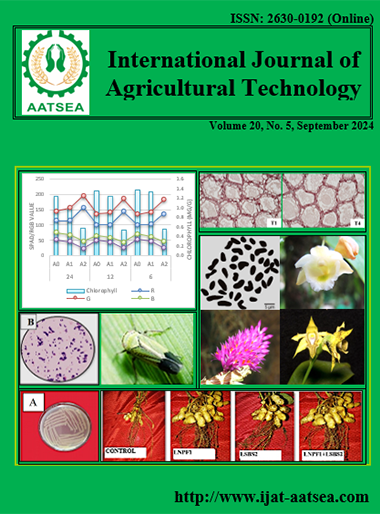Alginate coating with orange essential oil on extend shelf life of fresh cut Pomelo (Citrus grandis L. Osbeck cv. Khao Yai)
Main Article Content
Abstract
The result indicated that the use of coatings can reduce the weight loss and respiration rate. The appearance of a non-treated coating in fresh cut pomelo had distinctly separated pulp as compared to a treated coating in fresh cut pomelo, according to color change of pulp was measured by L*, a*, b*, and Hue value. Regarding, the study of chemical change as total soluble solid (TSS), total titratable acidity (TA) and ascorbic acid raised that the chemical change was depended on storage time, which the coating had not affected on chemical change. It was found that the fresh cut pomelo in a treated coating with 1% alginate combined with 0.5% orange essential oil inhibited as the increasing in total plate count, yeast and mold during storage. The total plate count, yeast and mold were reduced because the orange essential oil expressed to control the microbial growth. Hence, the use of alginate coating with 0.5% orange essential oil can preserve the quality and extend the shelf life.
Article Details

This work is licensed under a Creative Commons Attribution-NonCommercial-NoDerivatives 4.0 International License.
References
AOAC (1990). Association of Official Agricultural Chemists, Official Methods of Analysis, Washington, DC, USA.
Conrad, C. M. (1926). A Biochemical study of the insoluble pectin substances in vegetables. American Journal of Botany, 13:531-547.
Duong, N. T. C., Uthairatanakij, A., Laohakunjit, N., Jitareerat, P. and Kaisangsri, N. (2023). Cross-linked alginate edible coatings incorporated with hexyl acetate: Film characteristics and its application on fresh-cut rose apple. Food Bioscience, 52:102410.
Edogbanya, P. R. O., Suleiman, M. O., Olorunmola, J. B. and Oijagbe, I. J. (2019). Comparative study on the antimicrobial effects of essential oils from peels of three citrus fruits. MOJ Biology and Medicine, 4:49-54.
Ennab, H. A., El-Shemy, M. A. and Alam-Eldein, S. M. (2020). Salicylic acid and putrescine to reduce post-harvest storage problems and maintain quality of murcott mandarin fruit. Agronomy, 10:115.
Gaowa, S., Feng, K., Li, Y., Long, Y. and Hu, W. (2023). Effect of alginate-based edible coating containing thyme essential oil on quality and microbial safety of fresh-cut potatoes. Horticulturae, 9:543.
Gombotz, W. R. and Wee, S. (1998). Protein release from alginate matrices. Advanced Drug Delivery Reviews, 31:267-285.
Gomes, M. S., Cardoso, M. G., Guimarães, A. C. G., Guerreiro, A. C., Gago, C. M. L., Vilas Boas, E. V. B. Dias, C. M. B., Manhita, A. C. C., Faleiro, M. L., Miguel, M. G. C. and Antunes, M. D. C. (2017). Effect of edible coatings with essential oils onthe quality of red raspberries over shelf-life. Journal of the Science of Food and Agriculture, 97:929-938.
Hadidi, M., Majidiyan, N., Jelyani, A. Z., Moreno, A., Hadian, Z. and Khaneghah, A. M. (2021). Alginate/Fish gelatin-encapsulated lactobacillus acidophilus: A study on viability and technological quality of bread during baking and storage. Foods, 10:2215.
Kale, P. N. and Adsule, P. G. (1995). “Citrus” Handbook of fruit science and technology: production, composition, storage and processing, New York, pp.39-65.
Kameshwar, A. K. S. and Qin, W. (2018). Structural and functional properties of pectin and lignin–carbohydrate complexes de-esterases: a review. Bioresour. Bioprocess, 5:43.
Mathooko, F. M. (1996). Regulation of respiratory metabolism in fruits and vegetables by carbon dioxide. Postharvest Biology and Technology, 9:247-264.
Parreidt, T. S., Müller, K. and Schmid, M. (2018). Alginate-based edible films and coatings for food packaging applications. Foods, 7:170.
Pesis, E. (2005). The role of the anaerobic metabolites, acetaldehyde and ethanol, in fruit ripening, enhancement of fruit quality and fruit deterioration. Postharvest Biology and Technology, 37:1-19.
Prietsch, K. M., Wachholz, B. S., El Halal, S. L. M., Gandra, E. A., Mendonça, C. R. B., and Borges, C. D. (2022). Preservation of frozen strawberries enriched with Saccharomyces boulardii using gelatin-based coating. Acta Scientiarum. Technology, 45:60764.
Rodríguez, F. R., Cortés, C. G. and Moreno, C. D. (2015). Influence of chitosan coatings with citric essential oil on the shelf-life of minimally processed mango (Mangifera indica L.). Revista Facultad Nacional de Agronomía Medellín, 68:7679-7688.
Vanoli, M., Grassi, M., Buccheri, M. and Rizzolo, A. (2015). Influence of edible coatings on postharvest physiology and quality of Honeydew melon fruit (Cucumis melo L. inodorus). Advances in Horticultural Science, 29:65-74.
Yang, X. N. and Kang, S. C. (2013). Chemical composition, antioxidant and antibacterial activities of essential oil from Korean Citrus unshiu peel. Journal of Agricultural Chemistry and Evironment, 2:42-49.
Yin, C., Huang, C., Wang, J., Liu, Y., Lu, P. and Huang, L. (2019). Effect of chitosan- and alginate-based coatings enriched with cinnamon essential oil microcapsules to improve the postharvest quality of mangoes. Materials, 12:2039.


